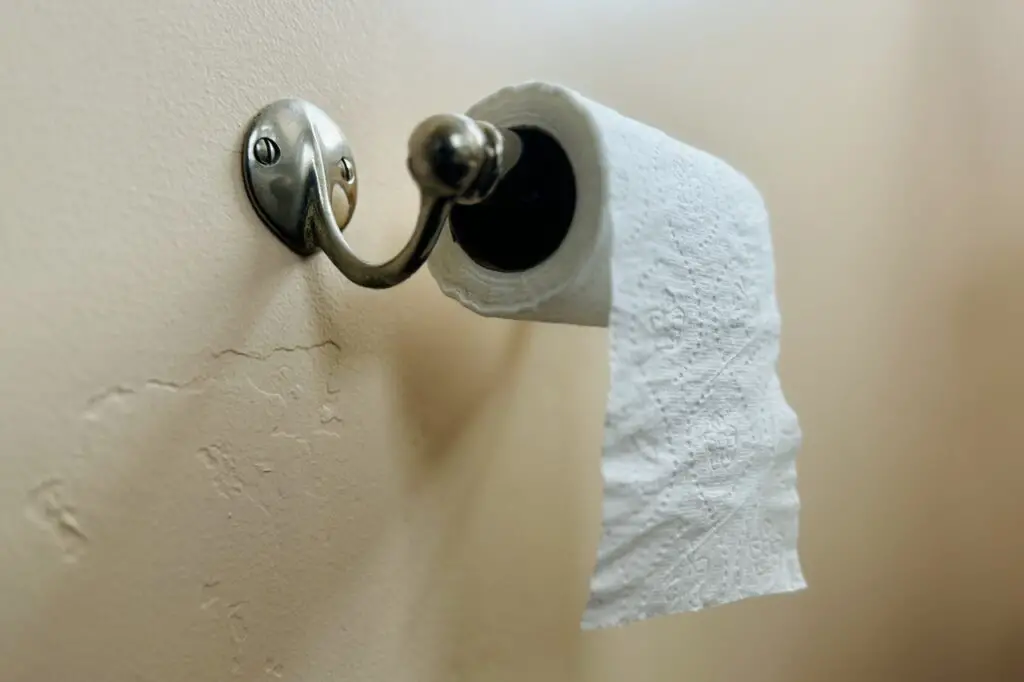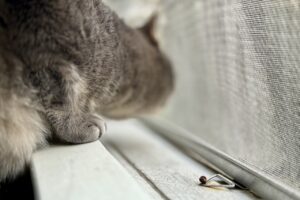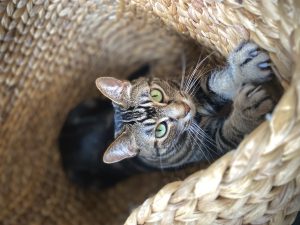Guide to Cat-Proofing Your Bathroom
This article is your guide for how to cat-proof, or kitten-proof, the bathroom. We’ve included 13 hazards to address – use the table of contents as a checklist.
The most common and complex issue is with toilet paper, so let’s start there, shall we?
1. Toilet Paper Holder
Have you ever walked into your bathroom to find that your cat has gleefully unraveled the entire roll of toilet paper from the holder onto the floor? Even shredded it to tiny bits?
If so, we have at least one thing in common.
Yes, this is a thing with some cats. It feels like a close cousin to the cat behavior of pushing objects off of high surfaces just to watch them fall!

Why do cats unravel toilet paper?
As annoying as this issue can be, it helps to remember that cats need and seek outlets for hunting, scratching, and playing. If your cat is messing with the TP, he is simply meeting one of those basic cat needs.
So, this is your cat expressing basic instincts, not “being bad.” Never punish or scold – it won’t help and will only damage the bond you have with your cat. Your cat may simply be bored, or need redirection and training focused on cat behaviors that are more acceptable.
You may also need to change your TP setup, at least temporarily.
Solutions to Toilet Paper Problems
For some cats, all it takes is to turn the roll around so that the paper is coming off closest to the wall. But for cats that have developed a habit of chewing on the roll, you may need to try installing a covered dispenser, or keep the roll in a container for a time.
For those whose cat won’t leave the toilet paper alone, we’ve provided a list of things to try, starting with easy/free all the way up to upgrading the TP holder. Results will vary depending on your cat and your situation, and how ingrained the current problem has become.
Here’s are some things you can try:
Potential Solutions to Toilet Paper Problems
- Turn the roll around so the paper hangs down closest to the wall
- Keep the roll on the counter or on the back of the toilet
- DIY toilet paper holder cover
- Install the dispenser higher up the wall and out of cat’s reach
- Keep the roll of TP enclosed in something (e.g., box or canister)
- Place a scratcher under or near TP holder
- Keep the bathroom door closed
- Get a covered TP holder
- Get a TP holder that lets you place the roll vertically instead of horizontally
It’s possible that after a certain length of time with an alternate setup, your cat no longer messes with the TP. So it may be worth experimenting. For example, try 3 months of preventing cat-access to the TP, then go back to your original system and see what happens. If 3 months doesn’t work, try a longer period of time.
Alternative Toilet Paper Holders
Installing a different TP holder can sometimes do the trick. Here are a couple options on an Amazon, and a DIY example.
Affiliate Disclosure: VerveCat is supported by readers. As a member of Amazon Associates and other affiliate programs, we may earn a commission at no added cost to you when you follow a product link and make a purchase.
Covered toilet paper holders
After combing through customer reviews for several models, these types of holders appear to solve the issue for some cat owners, but not others.
If you want to try it out, here’s an example of a covered TP holder on Amazon.
Vertical toilet paper holders
Some cats stop messing with the TP when the orientation of the roll is vertical instead of horizontal. Here’s an example of a vertical TP holder on Amazon. There are also free-standing models.
DIY toilet paper holders
Some people find success with DIY solutions, such as making a hard plastic sleeve that fits snugly over the roll. Here’s a DIY how-to guide from Hill’s if you want to try it out or get some inspiration.
2. Toilet
There are two hazards with toilets:
- Falling in and either making a mess or drowning (which is quite possible for kittens and elderly cats)
- Drinking from it. First of all – ew. Second, toilet water often has highly toxic chemicals, not to mention all manner of funk and bacteria.
The solution here is pretty simple: keep the toilet lid closed. And train everyone in your home to close the lid after every single toilet use.
When a cat is drinking from weird places, it usually means that their water dish has gone dry.
Occasionally I’ll find one of my cats hopping into the bathtub to lap up some droplets. And this leads me to discover that I’ve messed up and forgotten to refresh the water bowl (which you should do daily, by the way, because of germ build-up. Keep the bowl clean, not just filled). I just put a clean bowl of water down, show them it’s there, and we’re back on track!
In the unlikely event that your cat figures out how to get the toilet lid opened, you can use a cheap toilet seat lock to make that impossible. Also, if your cat is this determined, you should do some behavior detective work to figure out why.
3. Toilet Brush
Toilet brushes have toxic chemicals and bacteria on them. Cats are sometimes drawn to play with or chew on things with bristles. Play it safe and keep your toilet brush in an enclosed holder or put away in a cabinet.
4. Trash
There’s a lot of stuff that typically goes in the bathroom trash that is tempting to cats, but that can cause serious harm, especially if swallowed.
My cats have tried to eat floss, and also used Q-tips. What? Ew again.
Use a covered, bathroom-sized cat-proof trash can, like one with a foot lever. It can also work well to keep the trash in the cabinet under the sink, as long as the cabinet latches securely or is kept shut with a child lock.
5. Medication and Personal Care Products
Most human medications are highly toxic to a cat, and there are many hazardous personal care items kept in the bathroom as well.
Store medications, supplements, and personal care products in secure cabinets. This includes pain relievers, ointments, dental floss, hair care products, and toothpaste.
For low cabinets that don’t latch tight, use a child-lock or just don’t store anything toxic in there.
6. Bathtub and Sink
To remove drowning risk, don’t leave deep standing water unattended in the bathroom. This is especially important for kittens and disabled or elderly kitties who don’t move around so well.
7. Bathroom Cleaners and Chemicals
Store all cleaning supplies and chemicals safely out of paws’ reach to prevent poisoning. You might also consider alternatives to toxic cleaning agents that are safer for cats.
Again, for cabinets that don’t latch tight, use a child-lock or just play it safe and don’t store anything toxic in there.
8. Small Items and Miscellaneous Hazards
Keep small stuff like hair ties, jewelry, and shaving razors out of reach. Hair ties are a big one – similar to rubber bands and ribbon, very dangerous if swallowed by a cat.
9. Windows
If your bathroom has a window, you need to cat-proof it. This includes:
- making sure it has a screen in good condition and securely anchored in place (can’t be pushed out)
- making sure any draw cords (common on blinds) are gathered safely out of reach of your cat
10. Shower Curtain
If your cat takes to climbing or scratching the shower curtain, leave the bathroom door closed until your cat has learned to use designated cat stuff to meet these needs.
(Hint: provide vertical spaces and scratching surfaces throughout your home, and train your cat to use them)
Or you can use just the liner for a while (e.g., a few months), then put the curtain back up and see if it’s still tempting to climb.
11. Electrical Appliances and Tools
It’s probably best to keep hair dryers, straighteners, and other electrical tools shut in a cabinet or drawer when not in use.
If you’ve got electrical cords running to things that can’t be put away, consider using cord protectors or clips to keep them tidy and prevent chewing. If chewing is an issue, you can also try using bitter apple spray.
12. Plants
If you’re like me, you love having plants in the bathroom. Just make sure none of them are toxic if your cat can reach them.
13. Air Fresheners and Decorations
Don’t use air fresheners that are toxic to cats (and many are). This includes most fragrance sticks or reed diffusers that sit in oil.
Candles are also commonplace in bathrooms, but open flames and cats are just a big no-no. If real candles are an absolute must for your self-care bath routine, I get you – just make sure you keep the door shut and your cat out for as long as they’re lit.
Last Meows
We hope this guide helped you get your bathroom in proper shape for having a cat around. And shoot us an email if there’s an issue you’re having that isn’t covered here, or if any of these ideas made a difference for you.
When you’re ready to cat-proof the next part of your house, check out our comprehensive cat-proofing guide, or the quick-start checklist version.

